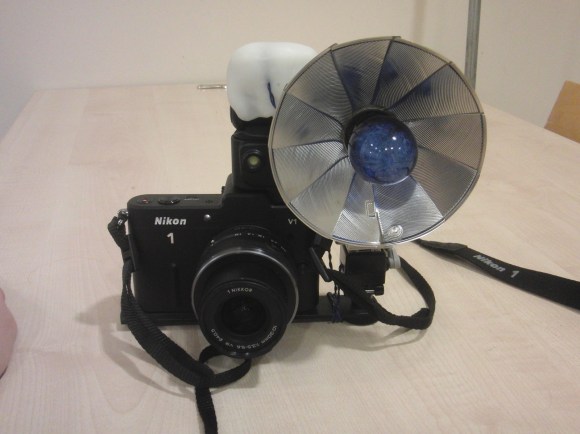
We don’t think this one is going to bring back the days of one-time-use flash bulbs. But for camera enthusiasts who do have old flash units lying around this will be quite interesting. [Sven] worked out a method of interfacing this vintage flash with a modern camera.
The trick is to map the trigger signal from the camera to the flash module. Instead of patching into an electrical signal from the camera he’s using the light from the stock flash. He cut an optocoupler in half, keeping the receiving side of the part. This is molded in plastic that was shaped to surround the original flash unit. When that flash goes off the triac in the remaining half of the IC is activated. This is connected to a hot shoe mounted on an extension arm that is attached to the camera’s tripod mount. The shoe can be used to interface a few different styles of flash modules.
We don’t have an alternative use in mind right now. But chopping an optocoupler in half could come in handy for other applications that use a bright light as a trigger event.
















Umm have you not heard of a CdS cell, or any number of other light sensors. No real need to cut an optical isolator in half.
CDS cells have a pretty slow response time, at least with regard to photography speeds. I’d suggest a discrete phototransistor or photodarlington – these are like half an optocoupler but in a proper package (often TO-92)
I did a quick search on Farnell and i can’t find any photo darlingtons that are not part of an optocoupler, neither do they handle very high currents.
What made me chose this method was the simplicity, i happened to have a couple of these optocouplers bought for another project and they worked perfectly, no need to build anything else. I could never match the cost of 1 dollar, or the size of half a DIP8 either.
Also, this is a triac that will handle both high currents and high voltages, and it works in both directions. There is no way i can connect it wrong, or find a flash unit that it can’t handle.
If you had it on hand it makes sense.
That’s an impressively awful way of doing things.
It’s a hack, in the trust sense of the word. I think it’s a great project, especially cutting an optocoupler in half (very clever!)
To those deriding the effort, the choice of the cut optocoupler was because photo-triacs that can handle the voltages and pulse currents of ancient flashes are just not available. They all need an electronic trigger, which is not trivial to get from a camera like a Nikon 1. This is a wonderful hack in the truest sense, using what’s around and what’s available to make something do something. Think a little before you declare something awful or terrible or useless. This scratches a specific itch, and does it in a way that properly implements the spirit and the definition of ‘hack’ in this context.
Ok, sawing an optotriac in half is a pretty fantastic kludge.
Are there any concerns about air getting inside? What does the IR channel inside look like?
The whole inside of the coupler is filled with a white semi transparent material so there is no real concern about hitting the right spot. In this particular coupler the emitter and receiver are offset far towards the receiving end, so cutting at the center is not a problem.
I don’t believe these semiconductors are sensitive to air, even if it’s unlikely to get through the transparent plastic.
A very very interesting thing would be the opposite: Adapting a modern external flash to use with vintage classical cameras ;)
That shouldn’t be too hard, many modern flashes that use a standard size flash shoe will trigger from an old style hot shoe with just 2 contacts.